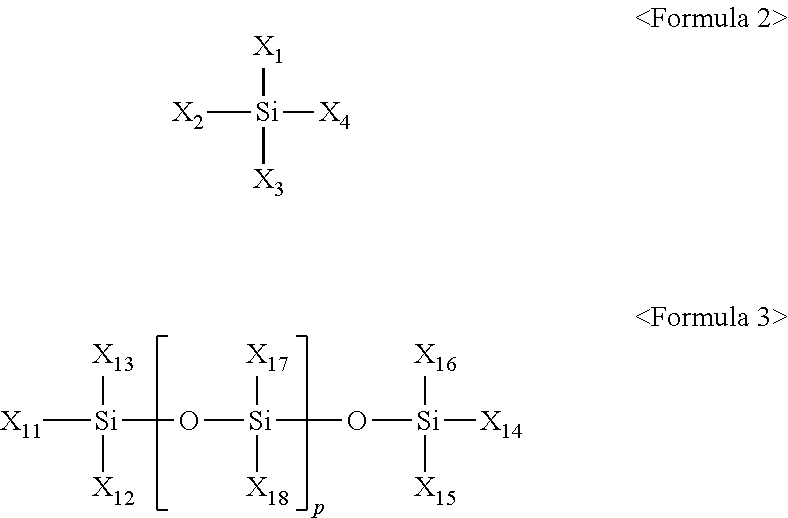Organic light emitting device and method for preparing the same
a light-emitting device and organic technology, applied in the direction of basic electric elements, semiconductor devices, electrical equipment, etc., can solve the problems of deterioration of organic light-emitting diodes, and achieve the effect of preventing oxygen and/or moisture permeation and prolonging the li
- Summary
- Abstract
- Description
- Claims
- Application Information
AI Technical Summary
Benefits of technology
Problems solved by technology
Method used
Image
Examples
example 1
[0129]The compounds listed in Table 1, each in an amount in Table 1, were mixed together, and filtered through a 0.2 μm cylinder filter to prepare an organic film forming composition:
[0130]
TABLE 1CompoundAmountSilicon-based1,3-bis(2-methacryloxypropyl)-40 mmolcompoundtetramethyl disiloxane(Mw 386.64)Curable material1,10-decamethylene glycol dimethacrylate40 mmol(Mw 310.43)Trimethylolpropane triacrylate20 mmol(Mw 296.32)InitiatorTPO 4 mmol
[0131]The organic film forming composition was applied on a silicon wafer using a flash evaporation system (available from SNU), and then exposed to a light source having a wavelength of about 390 nm to form an organic film.
[0132]The silicon wafer with the organic film was loaded onto a PECVD system, and was then exposed to an oxygen plasma condition (50 W, 100 mtorr, O2 50 sccm) for about 0 sec, 60 sec, 90 sec, and 120 sec, followed by measuring thicknesses of the organic film. The results are shown in Table 2 below.
[0133]
TABLE 2Oxygen plasmaexposu...
example 2
[0134]An organic film was formed on a silicon wafer in the same manner as in Example 1, except that compounds of Table 3 below, instead of the compounds of Table 1, were used.
[0135]
TABLE 3CompoundAmountSilicon-based1,3-bis(2-methacryloxypropyl)-40 mmolcompoundtetramethyl disiloxane(Mw 386.64)Curable material1,10-decamethylene glycol dimethacrylate50 mmol(Mw 310.43)Trimethylolopropane triacrylate10 mmol(Mw 296.32)InitiatorTPO 4 mmol
[0136]The silicon wafer with the organic film was loaded onto a PECVD system, and was then exposed to an oxygen plasma condition (50 W, 100 mtorr, O2 50 sccm) for about 0 sec, 60 sec, 90 sec, and 120 sec, followed by measuring thicknesses of the organic film. The results are shown in Table 4 below.
[0137]
TABLE 4Oxygen plasmaexposure timeMeasured thickness of organic film 0 sec3090 Å60 sec3020 Å90 sec3019 Å120 sec 2994 Å
example 3
[0138]An organic film was formed on a silicon wafer in the same manner as in Example 1, except that compounds of Table 5 below, instead of the compounds of Table 1, were used.
[0139]
TABLE 5CompoundAmountSilicon-based1,3-bis(2-methacryloxypropyl)-50 mmolcompoundtetramethyl disiloxane(Mw 386.64)Curable materialtriethylene glycol dimethacrylate50 mmol(triethylene glycol dimethacrylate)(Mw 286.32)InitiatorBAPO 2 mmol
[0140]The silicon wafer with the organic film was loaded onto a PECVD system, and was then exposed to an oxygen plasma condition (50 W, 100 mtorr, O2 50 sccm) for about 0 sec, 60 sec, 90 sec, and 120 sec, followed by measuring thicknesses of the organic film. The results are shown in Table 6 below.
[0141]
TABLE 6Oxygen plasmaexposure timeMeasured thickness of organic film 0 sec4980 Å60 sec4971 Å90 sec4965 Å
PUM
 Login to View More
Login to View More Abstract
Description
Claims
Application Information
 Login to View More
Login to View More - Generate Ideas
- Intellectual Property
- Life Sciences
- Materials
- Tech Scout
- Unparalleled Data Quality
- Higher Quality Content
- 60% Fewer Hallucinations
Browse by: Latest US Patents, China's latest patents, Technical Efficacy Thesaurus, Application Domain, Technology Topic, Popular Technical Reports.
© 2025 PatSnap. All rights reserved.Legal|Privacy policy|Modern Slavery Act Transparency Statement|Sitemap|About US| Contact US: help@patsnap.com



